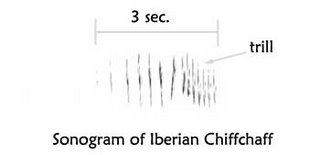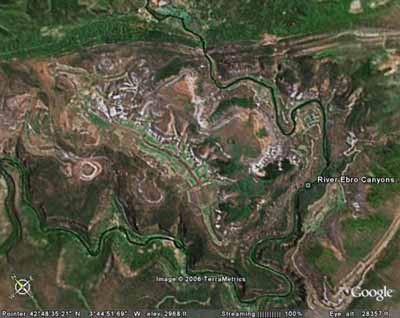
Ever since the spring has begun, it is very easy to listen with assiduity the song of the Chiffchaff, the Common Chiffchaff and Iberian Chiffchaff.
The abundance of Iberian Chiffchaff bigger that Common Chiffchaff, although he is not strange hearing to sing Iberian Chiffchaff and to few meters some Common Chiffchaff.
On the songs, there are differences in some aspects, but with a little experience it is possible to differentiate the two species.
Song of Iberian Chiffchaff.The song begins with a series of notes, hesitantly, monosyllabic and with a trill in the end.
This trill is the best difference with the song of the Common Chiffchaff .
 Song of the Common Chiffchaff.
Song of the Common Chiffchaff.
The song is slow, also monosyllabic , but without the trill in the end but long that the song of Iberian Chiffchaff.

The name of the Common Chiffchaff is one onomatopoeic of the song.
Problems.When they emit the typical song, the previous text is possible to apply, but this is not always possible because the songs can vary.
Iberian Chiffchaff sometimes it sings without emitting the last part (the trill). By that it is necessary to pay attention to the musicality. More happy: Iberian Chiffchaff, less happy: Common Chiffchaff.
Calls.These are more difficult, so that there are less differences.
Upward sound for Common Chiffchaff: "huitt---huitt"
Downward sound for Iberian Chiffchaff: "fiu.....fiu"
But is possible to find many variations of the calls, alert, contacts...
More information about the Iberian Chiffchaff
HERE
More information about the calls here:
http://www.rarebirdspain.net/arbsi026.htm













 We began our route, in the Valley of Zamanzas, between forest of beech trees and oaks, with the observation of Black Redstart, Chaffinch, and Pied Wagtail. In the direction of Campino village, we observed in the cliffs, groups of Red-billed Chough harassed by a Kestrel, as well as the Griffon Vultures located in the cornices.
We began our route, in the Valley of Zamanzas, between forest of beech trees and oaks, with the observation of Black Redstart, Chaffinch, and Pied Wagtail. In the direction of Campino village, we observed in the cliffs, groups of Red-billed Chough harassed by a Kestrel, as well as the Griffon Vultures located in the cornices.











